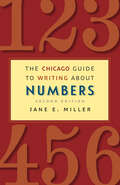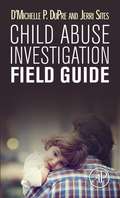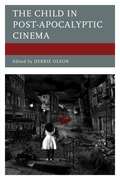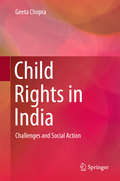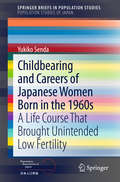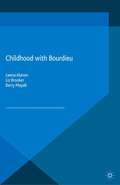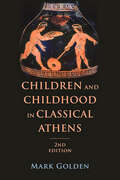- Table View
- List View
The Chicago Guide to Writing about Numbers, Second Edition (Chicago Guides to Writing, Editing, and Publishing)
by Jane E. MillerEarning praise from scientists, journalists, faculty, and students, The Chicago Guide to Writing about Numbers has helped thousands of writers communicate data clearly and effectively. Its publication offered a much-needed bridge between good quantitative analysis and clear expository writing, using straightforward principles and efficient prose. With this new edition, Jane Miller draws on a decade of additional experience and research, expanding her advice on reaching everyday audiences and further integrating non-print formats. Miller, an experienced teacher of research methods, statistics, and research writing, opens by introducing a set of basic principles for writing about numbers, then presents a toolkit of techniques that can be applied to prose, tables, charts, and presentations. Throughout the book, she emphasizes flexibility, showing writers that different approaches work for different kinds of data and different types of audiences. The second edition adds a chapter on writing about numbers for lay audiences, explaining how to avoid overwhelming readers with jargon and technical issues. Also new is an appendix comparing the contents and formats of speeches, research posters, and papers, to teach writers how to create all three types of communication without starting each from scratch. An expanded companion website includes new multimedia resources such as slide shows and podcasts that illustrate the concepts and techniques, along with an updated study guide of problem sets and suggested course extensions. This continues to be the only book that brings together all the tasks that go into writing about numbers, integrating advice on finding data, calculating statistics, organizing ideas, designing tables and charts, and writing prose all in one volume. Field-tested with students and professionals alike, this holistic book is the go-to guide for everyone who writes or speaks about numbers.
The Chicago Guide to Writing about Numbers, Second Edition (Chicago Guides to Writing, Editing, and Publishing)
by Jane E. MillerEarning praise from scientists, journalists, faculty, and students, The Chicago Guide to Writing about Numbers has helped thousands of writers communicate data clearly and effectively. Its publication offered a much-needed bridge between good quantitative analysis and clear expository writing, using straightforward principles and efficient prose. With this new edition, Jane Miller draws on a decade of additional experience and research, expanding her advice on reaching everyday audiences and further integrating non-print formats. Miller, an experienced teacher of research methods, statistics, and research writing, opens by introducing a set of basic principles for writing about numbers, then presents a toolkit of techniques that can be applied to prose, tables, charts, and presentations. Throughout the book, she emphasizes flexibility, showing writers that different approaches work for different kinds of data and different types of audiences. The second edition adds a chapter on writing about numbers for lay audiences, explaining how to avoid overwhelming readers with jargon and technical issues. Also new is an appendix comparing the contents and formats of speeches, research posters, and papers, to teach writers how to create all three types of communication without starting each from scratch. An expanded companion website includes new multimedia resources such as slide shows and podcasts that illustrate the concepts and techniques, along with an updated study guide of problem sets and suggested course extensions. This continues to be the only book that brings together all the tasks that go into writing about numbers, integrating advice on finding data, calculating statistics, organizing ideas, designing tables and charts, and writing prose all in one volume. Field-tested with students and professionals alike, this holistic book is the go-to guide for everyone who writes or speaks about numbers.
The Chicago Guide to Writing about Numbers, Second Edition (Chicago Guides to Writing, Editing, and Publishing)
by Jane E. MillerEarning praise from scientists, journalists, faculty, and students, The Chicago Guide to Writing about Numbers has helped thousands of writers communicate data clearly and effectively. Its publication offered a much-needed bridge between good quantitative analysis and clear expository writing, using straightforward principles and efficient prose. With this new edition, Jane Miller draws on a decade of additional experience and research, expanding her advice on reaching everyday audiences and further integrating non-print formats. Miller, an experienced teacher of research methods, statistics, and research writing, opens by introducing a set of basic principles for writing about numbers, then presents a toolkit of techniques that can be applied to prose, tables, charts, and presentations. Throughout the book, she emphasizes flexibility, showing writers that different approaches work for different kinds of data and different types of audiences. The second edition adds a chapter on writing about numbers for lay audiences, explaining how to avoid overwhelming readers with jargon and technical issues. Also new is an appendix comparing the contents and formats of speeches, research posters, and papers, to teach writers how to create all three types of communication without starting each from scratch. An expanded companion website includes new multimedia resources such as slide shows and podcasts that illustrate the concepts and techniques, along with an updated study guide of problem sets and suggested course extensions. This continues to be the only book that brings together all the tasks that go into writing about numbers, integrating advice on finding data, calculating statistics, organizing ideas, designing tables and charts, and writing prose all in one volume. Field-tested with students and professionals alike, this holistic book is the go-to guide for everyone who writes or speaks about numbers.
The Chicago Guide to Writing about Numbers, Second Edition (Chicago Guides to Writing, Editing, and Publishing)
by Jane E. MillerEarning praise from scientists, journalists, faculty, and students, The Chicago Guide to Writing about Numbers has helped thousands of writers communicate data clearly and effectively. Its publication offered a much-needed bridge between good quantitative analysis and clear expository writing, using straightforward principles and efficient prose. With this new edition, Jane Miller draws on a decade of additional experience and research, expanding her advice on reaching everyday audiences and further integrating non-print formats. Miller, an experienced teacher of research methods, statistics, and research writing, opens by introducing a set of basic principles for writing about numbers, then presents a toolkit of techniques that can be applied to prose, tables, charts, and presentations. Throughout the book, she emphasizes flexibility, showing writers that different approaches work for different kinds of data and different types of audiences. The second edition adds a chapter on writing about numbers for lay audiences, explaining how to avoid overwhelming readers with jargon and technical issues. Also new is an appendix comparing the contents and formats of speeches, research posters, and papers, to teach writers how to create all three types of communication without starting each from scratch. An expanded companion website includes new multimedia resources such as slide shows and podcasts that illustrate the concepts and techniques, along with an updated study guide of problem sets and suggested course extensions. This continues to be the only book that brings together all the tasks that go into writing about numbers, integrating advice on finding data, calculating statistics, organizing ideas, designing tables and charts, and writing prose all in one volume. Field-tested with students and professionals alike, this holistic book is the go-to guide for everyone who writes or speaks about numbers.
The Chicago Guide to Writing about Numbers, Second Edition (Chicago Guides to Writing, Editing, and Publishing)
by Jane E. MillerEarning praise from scientists, journalists, faculty, and students, The Chicago Guide to Writing about Numbers has helped thousands of writers communicate data clearly and effectively. Its publication offered a much-needed bridge between good quantitative analysis and clear expository writing, using straightforward principles and efficient prose. With this new edition, Jane Miller draws on a decade of additional experience and research, expanding her advice on reaching everyday audiences and further integrating non-print formats. Miller, an experienced teacher of research methods, statistics, and research writing, opens by introducing a set of basic principles for writing about numbers, then presents a toolkit of techniques that can be applied to prose, tables, charts, and presentations. Throughout the book, she emphasizes flexibility, showing writers that different approaches work for different kinds of data and different types of audiences. The second edition adds a chapter on writing about numbers for lay audiences, explaining how to avoid overwhelming readers with jargon and technical issues. Also new is an appendix comparing the contents and formats of speeches, research posters, and papers, to teach writers how to create all three types of communication without starting each from scratch. An expanded companion website includes new multimedia resources such as slide shows and podcasts that illustrate the concepts and techniques, along with an updated study guide of problem sets and suggested course extensions. This continues to be the only book that brings together all the tasks that go into writing about numbers, integrating advice on finding data, calculating statistics, organizing ideas, designing tables and charts, and writing prose all in one volume. Field-tested with students and professionals alike, this holistic book is the go-to guide for everyone who writes or speaks about numbers.
The Chicago Guide to Writing about Numbers, Second Edition (Chicago Guides to Writing, Editing, and Publishing)
by Jane E. MillerEarning praise from scientists, journalists, faculty, and students, The Chicago Guide to Writing about Numbers has helped thousands of writers communicate data clearly and effectively. Its publication offered a much-needed bridge between good quantitative analysis and clear expository writing, using straightforward principles and efficient prose. With this new edition, Jane Miller draws on a decade of additional experience and research, expanding her advice on reaching everyday audiences and further integrating non-print formats. Miller, an experienced teacher of research methods, statistics, and research writing, opens by introducing a set of basic principles for writing about numbers, then presents a toolkit of techniques that can be applied to prose, tables, charts, and presentations. Throughout the book, she emphasizes flexibility, showing writers that different approaches work for different kinds of data and different types of audiences. The second edition adds a chapter on writing about numbers for lay audiences, explaining how to avoid overwhelming readers with jargon and technical issues. Also new is an appendix comparing the contents and formats of speeches, research posters, and papers, to teach writers how to create all three types of communication without starting each from scratch. An expanded companion website includes new multimedia resources such as slide shows and podcasts that illustrate the concepts and techniques, along with an updated study guide of problem sets and suggested course extensions. This continues to be the only book that brings together all the tasks that go into writing about numbers, integrating advice on finding data, calculating statistics, organizing ideas, designing tables and charts, and writing prose all in one volume. Field-tested with students and professionals alike, this holistic book is the go-to guide for everyone who writes or speaks about numbers.
Child Abuse Investigation Field Guide
by D'Michelle P. DuPre Jerri SitesChildren are suffering from a hidden epidemic of child abuse and neglect. Every year more than 3 million reports of child abuse are made in the United States involving more than 6 million children. The United States has one of the worst records among industrialized nations – losing on average between four and seven children every day to child abuse and neglect. The WHO reports that over 40 million children, below the age of 15, are subjected to child abuse each year. Domestic violence in the home increases that risk threefold. Child Abuse Investigation Field Guide is intended to be a resource for anyone working with cases involving abuse, neglect or sexual assault of children. It is designed to be a quick reference and focuses on the best practices to use during a child abuse investigation. The guide explains the Minimal Facts Interview, the Forensic Interview, and the entire process from report to court. It is understood that every state has different statutes regarding these topics; however the objectives of recognizing, reporting, and investigating cases of this nature are the same. Just as every crime scene is different, every case involving a child is different. Best practices and standard procedures exist to help ensure cases are discovered, reported and investigated properly, to ensure good documentation is obtained to achieve prosecution and conviction. This field guide will be a useful tool for law enforcement, child protective services, social service caseworkers, child advocates, and other personnel and agencies working for the welfare of children.Includes protocols and best practices for child abuse investigationsExplains the Multidisciplinary Team approach and why it is usefulDescribes the Minimal Facts Interview and the Forensic InterviewWalks the reader from the initial report, through the investigation process, to pre-trial preparation and provides tips on court testimonyPortable and affordable, the guide is tabbed for easy access of specific information while in the field and can ensure that team members are “on the same page" throughout the investigation
Child development and the brain: An introduction
by Rob Abbott Esther BurkittThis accessibly written textbook explores how our increasing knowledge of neuroscience and advances in methods of investigation is changing our understanding of child development. Packed full of images, case studies, reflection points, further reading suggestions and a full glossary of technical terms, it examines key aspects of development such as emotion, memory, learning, perception and language, as well as neurodevelopmental disorders. It is designed to introduce undergraduate students on social science courses to the science behind the brain, looking at how it is structured and how it develops from a tiny cluster of cells into a complex dynamic structure that controls every aspect of our very existence.
Child development and the brain: An introduction
by Rob Abbott Esther BurkittThis accessibly written textbook explores how our increasing knowledge of neuroscience and advances in methods of investigation is changing our understanding of child development. Packed full of images, case studies, reflection points, further reading suggestions and a full glossary of technical terms, it examines key aspects of development such as emotion, memory, learning, perception and language, as well as neurodevelopmental disorders. It is designed to introduce undergraduate students on social science courses to the science behind the brain, looking at how it is structured and how it develops from a tiny cluster of cells into a complex dynamic structure that controls every aspect of our very existence.
Child In Post-apocalyptic Cinema (PDF)
by Olson O. Barros-Grela James M. Hodapp Frank Jacob Cassandra L. Jones Betül Ateçi Koçak Eric D. Miller Debbie Olson María Bobadilla Pérez Tarah Brookfield Jennifer Brown Glen Donnar Aryak Guha Mark Heimermann Joseph Wiinikka-Lydon Eduardo Barros-GrelaThe child in many post-apocalyptic films occupies a unique space within the narrative, a space that oscillates between death and destruction, faith and hope. The Child in Post-Apocalyptic Cinema interrogates notions of the child as a symbol of futurity and also loss. By exploring the ways children function discursively within a dystopian framework we may better understand how and why traditional notions of childhood are repeatedly tethered to sites of adult conflict and disaster, a connection that often functions to reaffirm the rightness of past systems of social order. This collection features critical articles that explore the role of the child character in post-apocalyptic cinema, including classic, recent, and international films, approached from a variety of theoretical, methodological, and cultural perspectives."
Child Protection, Public Health and Nursing (Protecting Children and Young People)
by Jane V. Appleton Sue PeckoverHighlighting and examining the vital role of nurses in protecting children from maltreatment, this book explores the input of nurses from different disciplines to the work of protecting children and young people. It draws on relevant theoretical, research and policy literature but focuses in particular on the evidence base for the value of their work.While orientated towards UK practice, the book includes some comparative material to add a wider European perspective. The text includes discussion of specialist public health nursing roles such as health visiting and school nursing, as well as the contribution of those who have more general nursing roles but whose work brings them into contact with children, young people and their families.This volume will inform all qualified nurses working in acute care and primary care settings who have contact with children, young people and their families. It will also be of use to those undertaking post-qualifying and post-graduate courses and is particularly relevant for Specialist Community Public Health Nurses (SCPHNs) many of whom, once qualified, have significant child protection roles in practice.
Child Rights in India: Challenges and Social Action
by Geeta ChopraThe book is a comprehensive compendium on child rights in India from a child development perspective. It discusses the challenges that Indian children face for survival, development and education, especially if they are marginalized through disability, lack of care, and poverty. The major issues expounded by the author in relation to rights are infant and child survival, early child development, street and working children, children in conflict with law, children with disabilities, child trafficking and child sexual abuse. The author goes further to delve into the causes, among which are high population, poverty, migration, illiteracy, poor legislation and deep-rooted social norms and behaviour. The book presents the existing policy and legal framework in India for each of these issues. The broad purpose of the book is to comprehensively discuss the roadblocks that the marginalized child in India faces, to understand the causes of these roadblocks and to evaluate government and civil society action for children in India.
Child Street Life: An Inside View of Hazards and Expectations of Street Children in Peru (SpringerBriefs in Well-Being and Quality of Life Research #15)
by G.K. Lieten Talinay StrehlThis brief studies the phenomenon of street children in two cities in Peru. It looks at some of the conceptual issues and, after analysing why children are in the street and what behaviour and which aspirations they exhibit, deals with the policy issues and lessons to be learned. This brief investigates when and why the transition from children on the street (street-working children) to children of the street (street living children) takes place and elucidates how they survive. It explains the fluidity and the risks involved in any type of child street life.
Child Welfare Systems and Migrant Children: A Cross Country Study of Policies and Practice (International Policy Exchange)
by Marit Skivenes, Ravinder Barn, Katrin Križ and Tarja PösöChild Welfare Systems and Migrant Children examines where, why and to what extent immigrant children are represented in the child welfare system in different countries. These countries include Australia/New Zealand, Belgium/the Netherlands, England, Estonia, Canada, Finland, Italy, Germany, Spain, Norway, and the United States--all of them having different child welfare philosophies and systems as well as histories and practices in immigration. By comparing policies and practices in child welfare systems (and welfare states), especially in terms of how they conceptualize and deal with immigrant children and their families, we address an immensely important and pressing issue in modern societies. Immigrants in the child welfare system are a critical issue and they seem to face serious challenges that are evident across countries. These are challenges related to lack of language proficiency, lack of knowledge about cultural and social aspects and about the public systems of the destination country. Perhaps most relevantly, the challenges may include collisions of ideas and beliefs about how to raise children, about children's place in the family and society, and about children's rights.
Childbearing and Careers of Japanese Women Born in the 1960s: A Life Course That Brought Unintended Low Fertility (SpringerBriefs in Population Studies)
by Yukiko SendaThis book provides the keys to understanding the trajectory that Japanese society has followed toward its lowest-low fertility since the 1980s. The characteristics of the life course of women born in the 1960s, who were the first cohort to enter that trajectory, are explored by using both qualitative and quantitative data analyses. Among the many books explaining the decline in fertility, this book is unique in four ways. First, it describes in detail the reality of factors concerning the fertility decline in Japan. Second, the book uses both qualitative and quantitative methods to introduce the whole picture of how the low-fertility trend began in the 1980s and developed in the 1990s and thereafter. Third, the focus is on a specific birth cohort because their experiences determined the current patterns of family formation such as late marriage and postponed childbirth. Fourth, the book explores the knife-edge balance between work and family conditions, especially with regard to childbearing, in the context of Japanese management and gender norms. After examining the characteristics of demographic and socioeconomic circumstances of postwar Japan in detail, it can be seen that the change in family formation first occurred drastically in the 1960s cohort. Using both qualitative interview data cumulatively from 150 people and quantitative estimates with official statistics, this book shows how individual-level choices to balance work and family obligations resulted in a national-level fertility decline. Another focus of this book is the increasing unintended infertility due to postponed pregnancy, a phenomenon that is attracting great social attention because the average age of pregnancy is approaching the biological limit. This book is a valuable resource for researchers who are interested in the rapid fertility decline as well as the work–life balance and the life course of women in Japanese employment practice and family traditions.
Childhood Adversity and Developmental Effects: An International, Cross-Disciplinary Approach
by Lisa Albers ProckChild trauma and violence is not an issue that is constrained to one nationality or one ethnicity. A staggering number of children around the world are subjected to violence and abuse, both domestic and political. The current volume examines the issue of developmental trauma from a variety of viewpoints, including sociological, epidemiological, gen
Childhood and Colonial Modernity in Egypt (Palgrave Studies in the History of Childhood)
by Heidi MorrisonThis book examines the transformations of Egyptian childhoods that occurred across gender, class, and rural/urban divides. It also questions the role of nostalgia and representation of childhood in illuminating key underlying political, social, and cultural developments in Egypt.
Childhood and Disability in the Nordic Countries: Being, Becoming, Belonging (Studies in Childhood and Youth)
by Rannveig Traustadóttir Borgunn Ytterhus Snæfrídur Thóra Egilson Berit BergThis collection provides a comprehensive insight into disabled children and youth in Nordic countries. It seeks to understand the experiences of children from their own perspectives and takes a multidisciplinary approach grounded in the new social studies of childhood and the Nordic relational approach to disability.
Childhood and youth (Moral panics in theory and practice)
by Gary ClaptonChildhood and youth have often been the targets of moral panic rhetoric. This Byte explores a series of pressing concerns about young people: child abuse, child pornography, child sexual exploitation, child trafficking and the concept of childhood. With an appraisal of the work of the influential thinker, Geoffrey Pearson, who wrote on deviance and young people, it draws attention to the moralising within these discourses and asks how we might do things differently.
Childhood with Bourdieu (Studies in Childhood and Youth)
by Berry Mayall Leena Alanen Liz BrookerThis collection is an engaging exploration of how Bourdieu's key concepts - field, habitus and capital - help us re-think the status of childhood. The authors are committed to improving the social status and well-being of childhood in social, economic and political worlds that too often fail to accord children respect for their human rights.
Childhood, Youth and Emotions in Modern History: National, Colonial and Global Perspectives (Palgrave Studies in the History of Emotions)
by Stephanie OlsenChildhood, Youth and Emotions in Modern History is the first book to innovatively combine the history of childhood and youth with the history of emotions, combining multiple national, colonial, and global perspectives.
Children and Childhood in Classical Athens (Ancient Society and History)
by Mark GoldenFirst published in 1990, Children and Childhood in Classical Athens was the first book in English to explore the lives of children in ancient Athens. Drawing on literary, artistic, and archaeological sources as well as on comparative studies of family history, Mark Golden offers a vivid portrait of the public and private lives of children from about 500 to 300 B.C. Golden discusses how the Athenians viewed children and childhood, describes everyday activities of children at home and in the community, and explores the differences in the social lives of boys and girls. He details the complex bonds among children, parents, siblings, and household slaves, and he shows how a growing child’s changing roles often led to conflict between the demands of family and the demands of community.In this thoroughly revised edition, Golden places particular emphasis on the problem of identifying change over time and the relationship of children to adults. He also explores three dominant topics in the recent historiography of childhood: the agency of children, the archaeology of childhood, and representations of children in art. The book includes a completely new final chapter, text and notes rewritten throughout to incorporate evidence and scholarship that has appeared over the past twenty-five years, and an index of ancient sources.
Children and Childhood in Colonial Nigerian Histories (African Histories and Modernities)
by Saheed AderintoThis book brings together the newest and the most innovative scholarship on Nigerian children—one of the least researched groups in African colonial history. It engages the changing conceptions of childhood, relating it to the broader themes about modernity, power, agency, and social transformation under imperial rule.
Children and Media: A Global Perspective
by Dafna LemishTaking a global and interdisciplinary approach, Children and Media explores the role of modern media, including the internet, television, mobile media and video games, in the development of children, adolescents, and childhood. Primer to global issues and core research into children and the media integrating work from around the world Comprehensive integration of work that bridges disciplines, theoretical and research traditions and methods Covers both critical/qualitative and quantitative approaches to the topic
Children and Media: A Global Perspective
by Dafna LemishTaking a global and interdisciplinary approach, Children and Media explores the role of modern media, including the internet, television, mobile media and video games, in the development of children, adolescents, and childhood. Primer to global issues and core research into children and the media integrating work from around the world Comprehensive integration of work that bridges disciplines, theoretical and research traditions and methods Covers both critical/qualitative and quantitative approaches to the topic
